Estimated reading time: 10 minutes
Why go to Uji?

The best Japanese tea and matcha is from the city of Uji. This is where Japan’s tea history started, and where the first tea trees from China was planted. I set aside one day during my Kyoto trip to venture out to the tea capital of Japan (and its cute mascot!).
Located only 30 minutes from Kyoto Station, Uji is virtually unmissable for tea lovers and matcha fans. I was determined to make this day trip to fulfill my tea-starved soul. The first place to visit? Definitely the Chazuna Tea Museum!
- Why go to Uji?
- Check Out My Video on Uji! 🌱
- First Stop: Chazuna Tea Museum 🫖
- The History of Japanese Tea 🍃
- Types of Tea
- Uji vs. Shizuoka Tea Museums
- From the Fields to the Tea Room 🍵
- Culture of Tea: The Modern and Traditional
- Grinding Your Own Matcha at the Tea Museum 🍵
- The Tea House Experience
- Souvenir & Tea Shopping
- 1. Nakamura Tokichi
- 2. Itoh Kyuemon
- 3. Fukujuen
- Planning Your Visit to the Chazuna Tea Museum
- TL;DR Tea Museum
- Watch My Video
Check Out My Video on Uji! 🌱
First Stop: Chazuna Tea Museum 🫖
Located right in the heart of Uji, the Chazuna Museum (Google Maps) offers visitors an immersive journey into the incredible world of Japanese tea. Though it may not be as famous as the tea museums in Shizuoka Prefecture- Chazuna provides an equally enriching experience for tea lovers and tea culture enthusiasts.
Buy a ticket to the Chazuna Tea Museum in advance for the most convenience. You can buy it in advance and book a Matcha grinding class with a stone mill! 🍵🥺
I learned so much about the rich history of tea in Japan, played with the interactive exhibits, and saw the production process of different types of tea. The museum is a must-visit destination for tea lovers or anyone interested in the traditions and culture of Japanese tea!
Did you know? ✨
Uji’s town mascot is the green tea prince Oujichama!
This is Oujichama, the green-haired prince mascot of Uji City, Japan. Despite being a baby, Oujichama is a green tea sommelier. pic.twitter.com/uRhKSbADw8
— Mondo Mascots (@mondomascots) May 19, 2019
The History of Japanese Tea 🍃

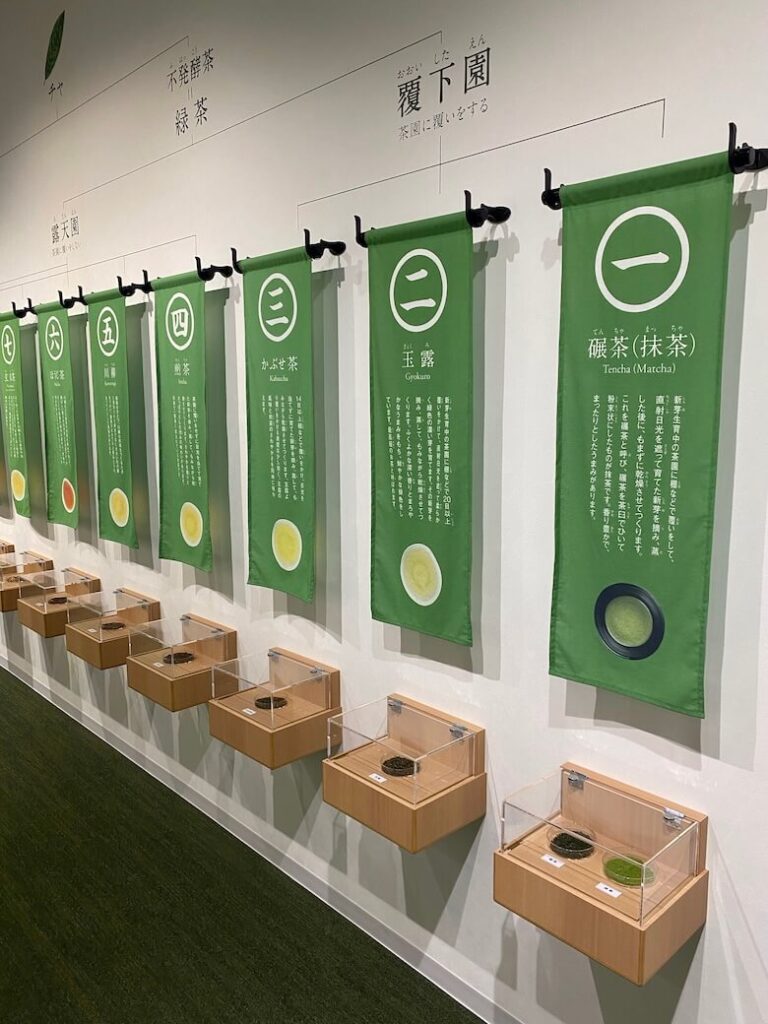
As you step into Chazuna, you’re immediately shown the different types of tea from Uji (Ujicha). These are teas produced in the Kyoto region and processed with special method from Uji.
Types of Tea
Did you know that there are 3 major types of tea?
1. Green tea: Unfermented tea
2. Oolong tea: Half-fermented tea
3. Black tea: Fermented tea
In the museum, they show 11 different teas, categorized based on its type. The most commonly drank tea in Japan is Sencha. It’s a green tea produced in an uncovered tea farm (rotenen)! In contrast, the precious Tencha & Matcha green tea is grown in a covered tea farm, where farmers erect shady covers to avoid direct sunlight.
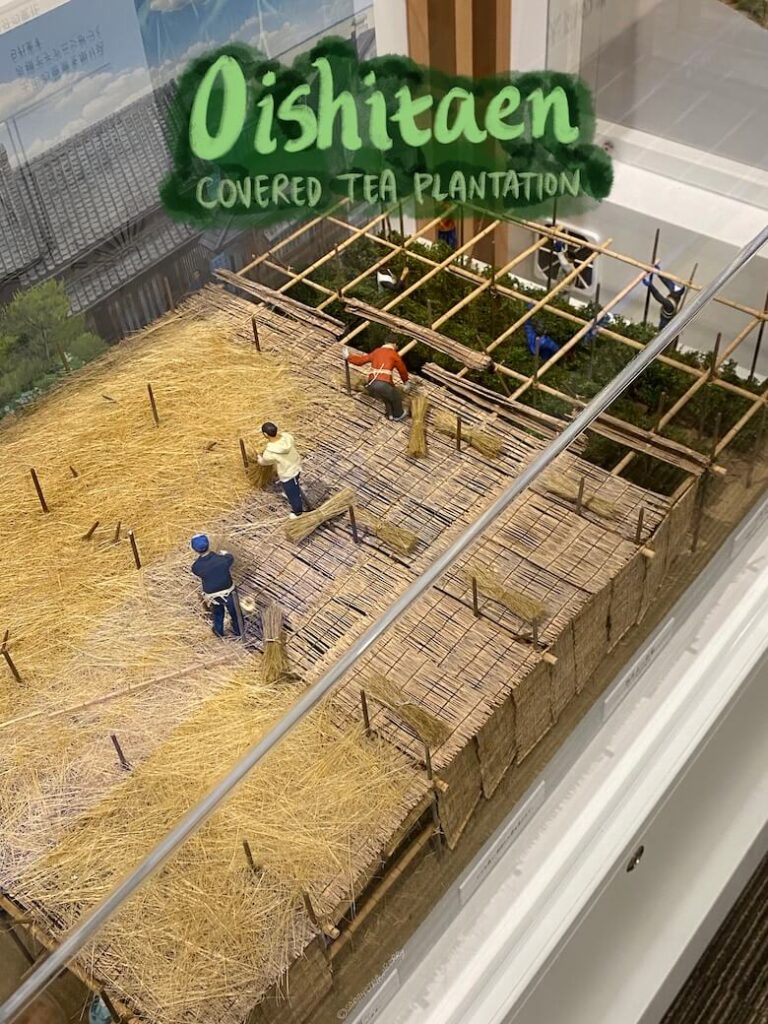
You will then watch a movie and be transported through the long history of tea in Japan. The Zen Buddhist monk Eisai first brought tea seeds from China to Japan in 1180. In the beginning, tea was used by Buddhist monks to avoid drowsiness during meditation.
Who knew that in the next few centuries tea became an upper-class drink of choice? The drink was also spread by the samurai society and it became an important part of their social interaction. Tea eventually trickled down to the common people, and is now enjoyed widely all over Japan.
Uji vs. Shizuoka Tea Museums
Unlike the World Tea Museum in Shizuoka, which focuses on global tea traditions, Chazuna emphasizes the unique story of Ujicha. The Uji tea has been cultivated in the region for centuries.
The exhibition takes you on a journey from the early Edo period, when tea first became popular in Japan, to the Meiji Restoration, which saw the modernization of tea production methods.
The exhibition rooms are filled with tea-related resources, including historical documents, tea utensils, and artifacts that illustrate the development of tea culture in Japan. Visitors can learn about the different types of tea, from the prized Uji-cha to varieties from as far as Yunnan Province and Sri Lanka.
The museum also explores the history of Japanese tea, including the influence of the Kamakura period and the role of tea in Japanese culture and society.
From the Fields to the Tea Room 🍵
One of Chazuna’s highlights is its interactive experience zones, which allow visitors to engage with the tea production process in a hands-on way. While you won’t find the expansive tea plantations of the Makinohara Plateau here, the museum’s clever design allows guests to feel connected to the local tea industry. Visitors can participate in tea picking simulations, where they learn about the careful selection of tea leaves and the importance of quality in tea production.
The museum also offers factory tours that provide insight into the production methods used in the surrounding Uji tea fields. These tours highlight the meticulous processes involved in creating high-quality Japanese green tea. They show the complete process: from steaming and rolling the leaves to drying and packaging the final product.
Visitors can observe the use of traditional techniques alongside modern innovations, gaining a deeper appreciation for the craftsmanship involved in tea production. It really felt so real, seeing up close each one of the processes!
Culture of Tea: The Modern and Traditional
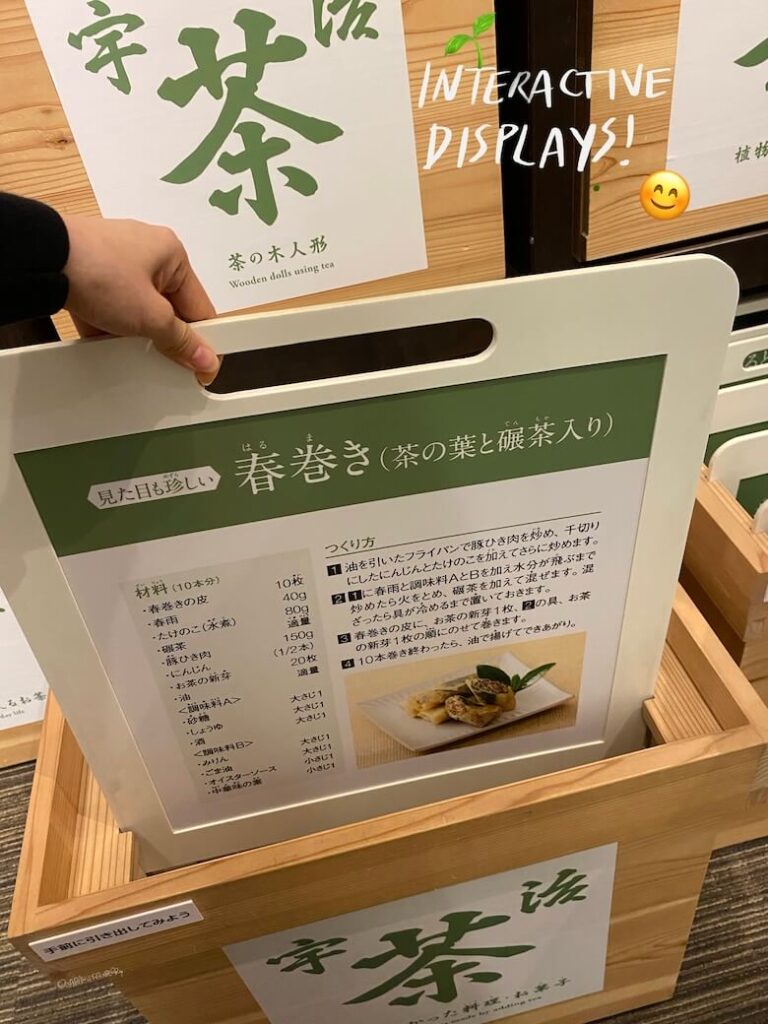
Chazuna embraces technology to enhance the user experience. The museum offers movies and interactive displays that allow visitors to explore the world of tea in an engaging way.
I really liked the information they provide on the different types of tea, their origins, and their unique characteristics. They have some interactive exhibits that are only available in Japanese though, so get your Google Translate app cameras ready!
Did you know? ✨
At school, children in Uji has tea available on tap! How cool is that?!
The museum also features an interactive map that highlights the global reach of tea. It’s so fascinating to trace its journey from its origins in Yunnan Province to many places across Asia and beyond. This exhibit provides a comprehensive look of the tea industry, including the role of major tea-producing regions such as Sri Lanka. In the old days, the influence of historical trade routes also determined how tea was spread all over the world!
Grinding Your Own Matcha at the Tea Museum 🍵
One of the most popular activities at Chazuna is the opportunity to grind your own matcha powder using traditional stone mills. This hands-on experience connects visitors to the early Edo period techniques still used in high-quality tea production today. Participants learn about the meticulous grinding process that transforms tea leaves into the fine powder used for matcha, a staple of Japanese tea ceremonies.
Get your museum ticket and matcha grinding experience pass through Get Your Guide!
Grinding matcha by hand allows visitors to appreciate the labor and skill involved in quality matcha creation. The experience also provides an opportunity to taste freshly prepared matcha. Check out their experience list and schedule before your visit to Chazuna- they are offered only on certain days and times! Matcha grinding is usually offered at 11 am and 1 pm daily.
The Tea House Experience
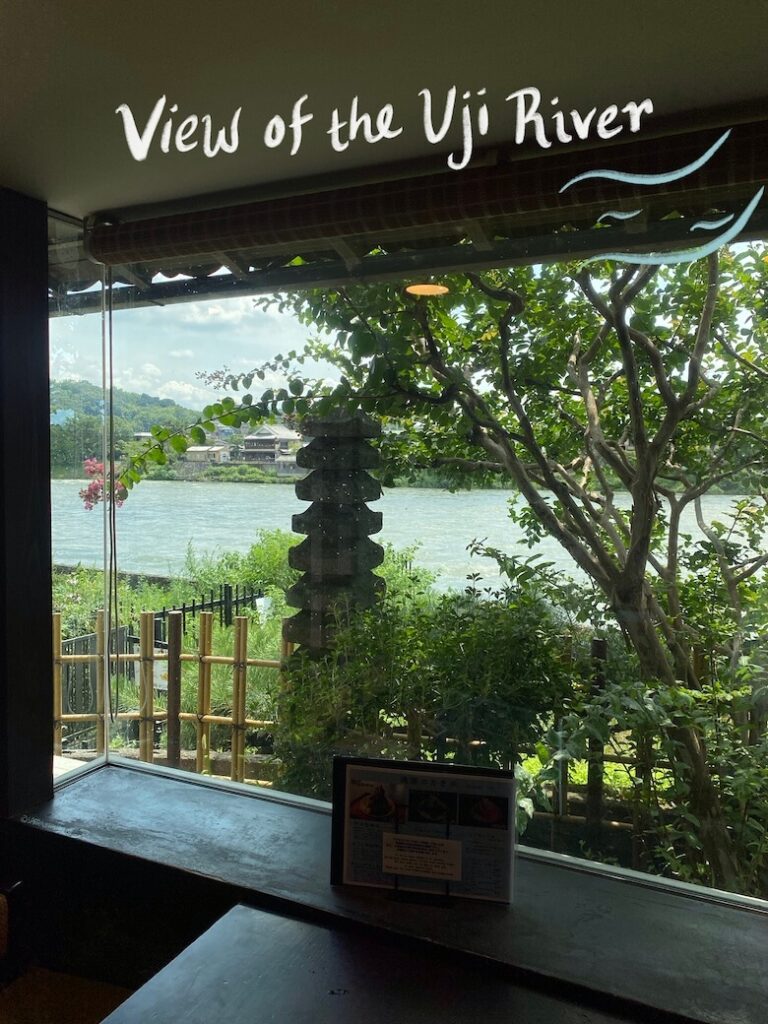
No visit to Uji is complete without stopping by the historic Tsuen tea house (Google Maps). In this charming traditional tea house, visitors can savor a perfect cup of roasted Ujicha while gazing out at the Uji River. Unlike the tea houses with views of Mount Fuji in Shizuoka, Tsuen offers a more intimate setting that reflects the traditions of Uji tea.
Hungry after our museum visit, we ordered main dishes and dessert. The tea house served us chilled glasses of roasted tea, with a refreshingly nutty flavor.
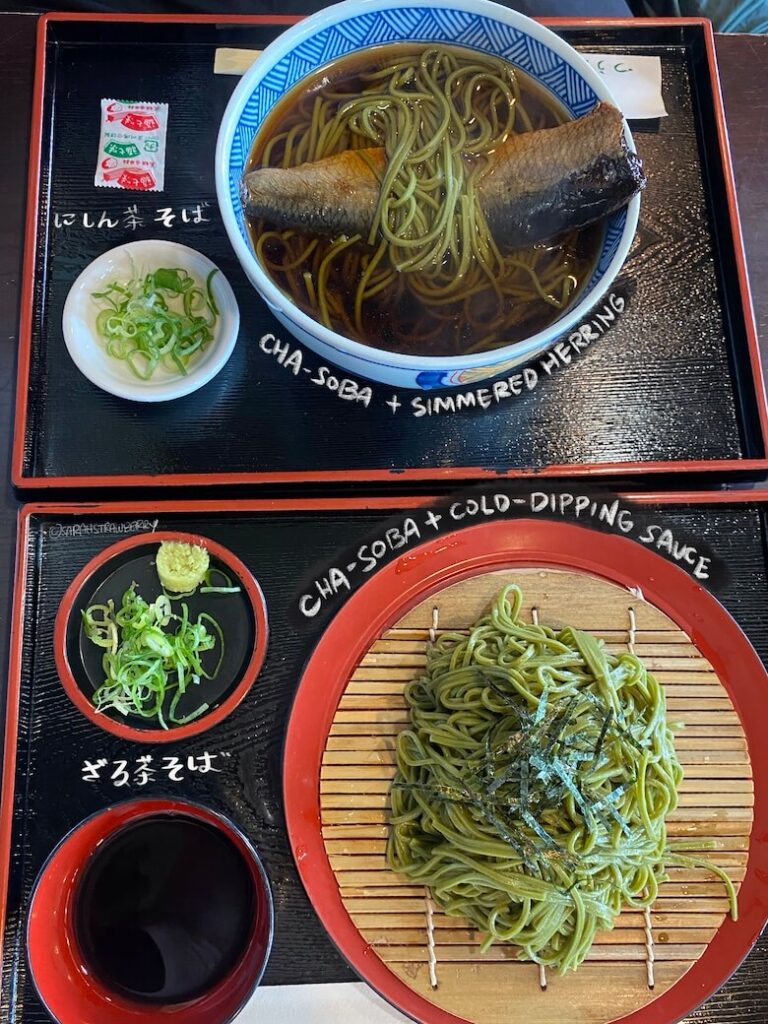
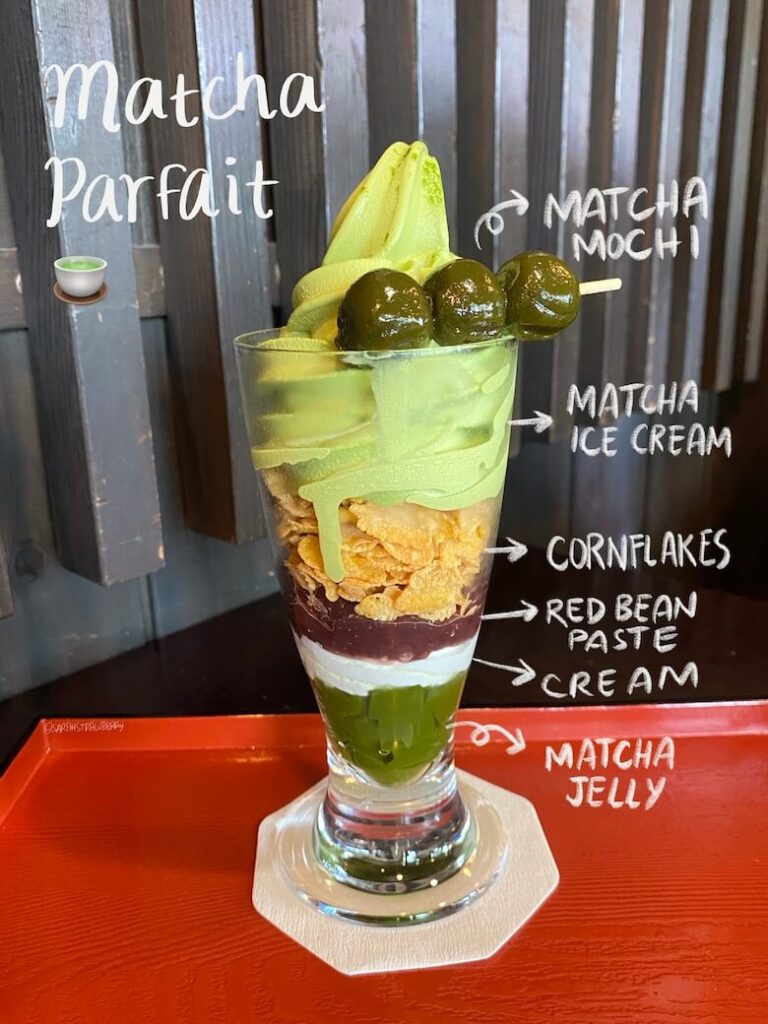
The server then brought us our meals: matcha soba, one cold (¥1,000) and one hot with grilled herring topping (¥1,200)! The latter is a specialty of Kyoto called Nishin Soba. It has a perfectly balanced hot broth made with soy sauce and sugar. Though the cold soba was refreshing for the summer heat, the herring soba was my favorite.
Then we moved on to dessert, and I was not disappointed. This was the best matcha parfait I’ve ever had! My previous favorite was from Nana’s Green Tea in Seattle- but this is another level of yum. The soft serve was creamy and rich, and the contrast of textures really wowed me. Crunchy cornflakes, jiggly jellies, and chewy mochi? I was in heaven!
After a satisfying meal, we ventured out to their shop next door to purchase teas and snacks to take back. I got a bag of their roasted tea and some green tea wafers.
Souvenir & Tea Shopping
There are some incredibly famous stores in Uji that you should definitely visit!
Pro Tip ✨
Visit Byodo-in Omotesando! This shopping street has all kinds of souvenirs form Uji. From tea-themed earrings, unique display items, to all kinds of snacks, you’ll find what you want here.
1. Nakamura Tokichi
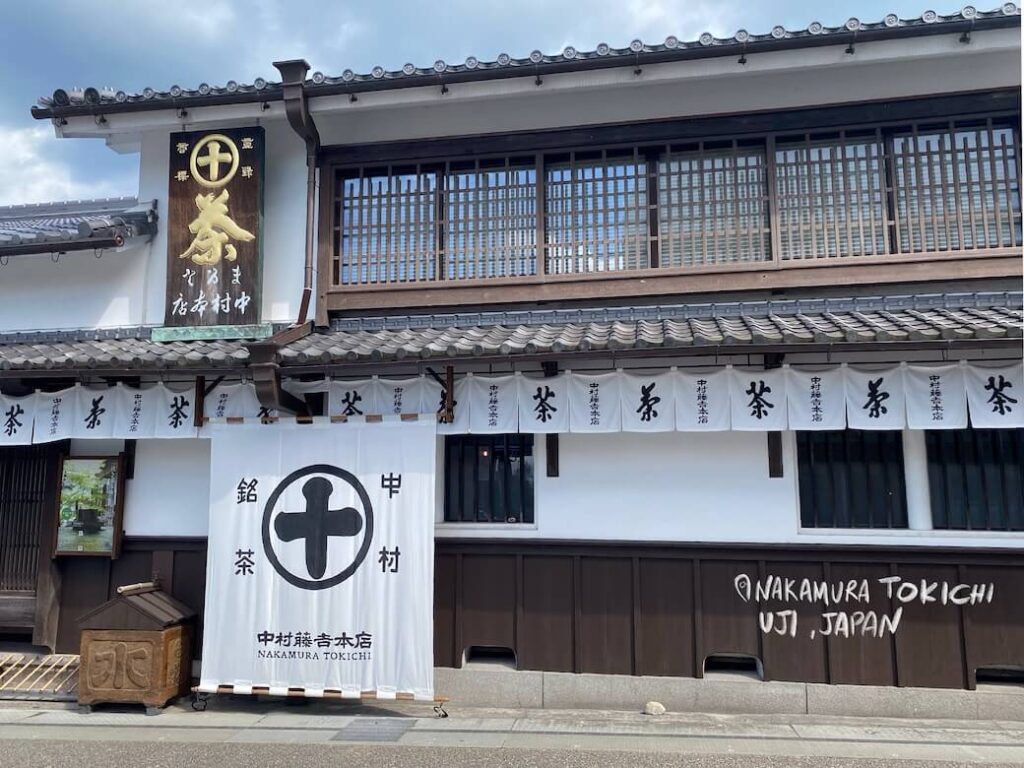
They used to be a royal family purveyor (reminds me of Fortnum & Masons)! This tea-focused restaurant was founded in 1854. This store also sells high quality matcha powders, special Nakamura tea, and sweets. Head down to their main store (Google Maps) for their complete collection.
2. Itoh Kyuemon
Visit this store for a wild variety of tea products. This tea merchant was founded in 1832. I even saw matcha curry, matcha cheesecakes, and matcha noodles!
3. Fukujuen
This historic company first started as a tea dealer in 1760. They have a tea room and tea workshops in Uji! Some of the workshops they offer are: tea incense making, matcha milling, and tea ceremony manners.
Planning Your Visit to the Chazuna Tea Museum
We went to Chazuna Museum from Kyoto. It is easily accessible from Uji Station, making it a convenient stop for tea enthusiasts. We walked around 10 minutes from the station to Chazuna Tea Museum.
The museum is located near the Tomei Expressway, which means that you can easily access it by car.
The admission fee is ¥600 per person.
To make the most of your visit, be sure to check the official website for the latest information on opening hours, admission fees, and available workshops. The museum hosts a lot of workshops and lectures on tea-related topics! There are matcha grinding workshops, tea canister decorating workshops, even
TL;DR Tea Museum
For the ultimate tea lovers, Chazuna Museum is a must visit to experience the world of Japanese tea. From its comprehensive exhibitions to its hands-on activities, Chazuna shows the city of Uji’s status as Japan’s tea capital. Learn about the history of tea in Japan, scrutinize every single process of tea-making up close, and attend workshops to make your own matcha!
Don’t forget to greet the city mascot Oujichama and buy a different teas in the city before you head back. Personally, I found it to be such a precious and fun trip.
Read more about my adventures in Japan and find out where the fortune cookie was actually invented! (hint: it’s not China nor the US!)
Watch My Video
@sarahstrawberry_ Tea capital of Japan, Uji 🍵 #japantravel #japanvlog #matchalover #teamuseum ♬ CLOUD BOSSA – フレネシ
Pin It!
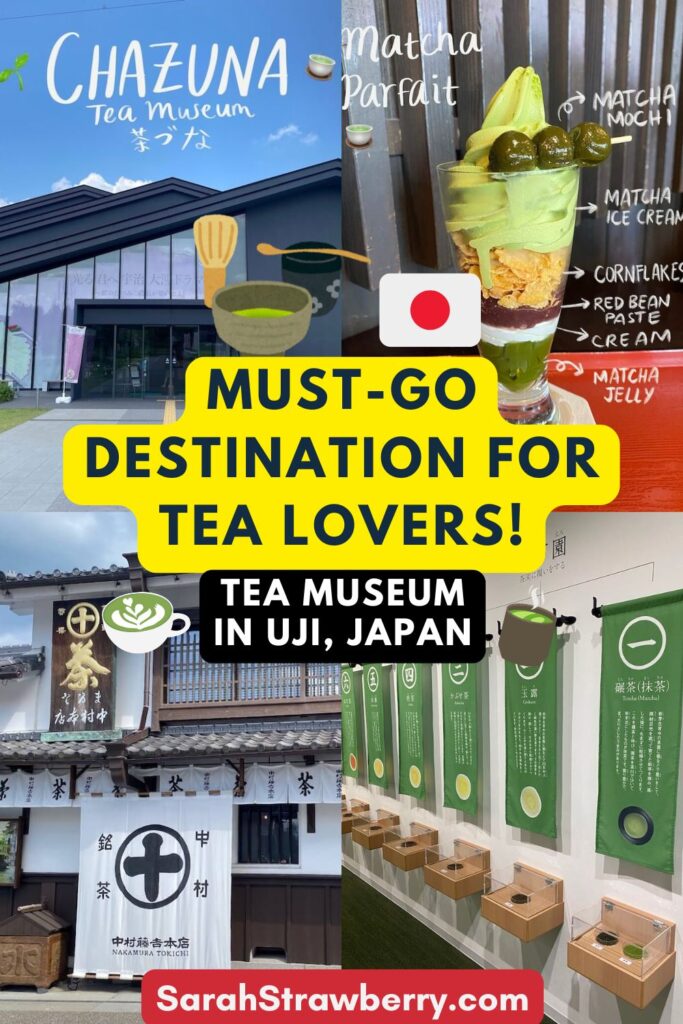

4 comments on “Japanese Tea Museum: The Best Green Tea is in Uji”